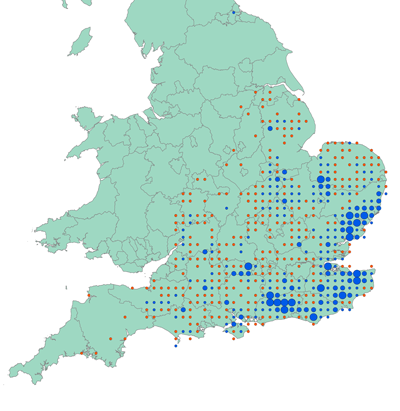Results
Orange = zero territories, Small blue = 1-10 territories,
Medium blue = 11-50 territories, Large blue = 51-150 territories
The majority of survey was completed in 2012 with remaining covererage gaps filled in 2013.
To recap, the main aims were to assess overall population size, compare numbers and distribution since the last survey conducted in 1999, and to gather new information on the distribution across different habitats.
A secondary but highly novel aim of the survey was to assess the pairing status of individual Nightingales. No previous survey of a breeding bird species in Britain, and possibly in Europe, has attempted to estimate what proportion of the territorial population might be pairs.
Understandably, most estimates of ‘breeding populations’ are based on singing or territory holding birds, yet this takes no account of how many of these birds may actually be paired and therefore probably breeding.
With the combined 2012 and 2013 counts, we now have a good basis for estimating population size and habitat use. Overall, a total of 3266 males were recorded from 2,356 tetrads.
The map shows the distribution of these territories recorded during main survey visits. It is worth pointing out that in both 2012 and 2013 there was a remarkable record of a territory holding bird in Cleveland, perhaps the most northerly record for many decades.
A total of 12 separate models were used, employing statistical techniques to estimate the numbers of birds likely to be present in areas which weren't covered and also to correct for detection – this is necessary because the probability of detecting all the territorial birds that are actually present on the survey visits is considerably less than 100%.
This resulting estimates gave population figures of between 5,094 and 5,938 territorial males. The mean population estimate, from the 12 models, was 5,542 with mean confidence limits of 5,090 (lower) and 5,995 (upper) territorial males. These results have now been published in a paper.
We now believe that the 1999 survey underestimated the population, mainly because strong emphasis was placed on nocturnal visits which tend to underestimate paired birds which are thought to sing less at night than unpaired birds.
There are plans to write two further journal papers based on the Nightingale survey. The first will focus on numbers, distribution and habitats. The second will address the issue of pairing success and will explore whether this varies with factors such as habitat type, position in the range and size of local population.







Share this page